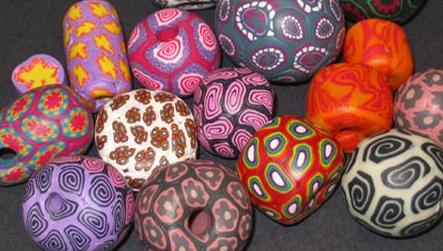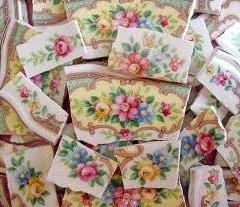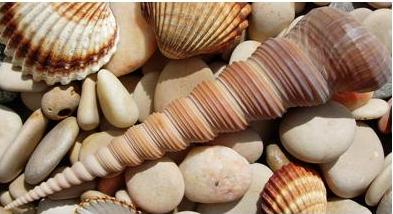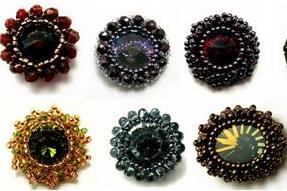Home
›
Getting Started
›
Tesserae
Tesserae
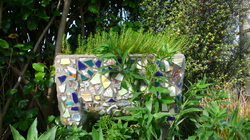
My first mosaic piece, my beloved concrete tub, is covered with tesserae of old jewellery, broken ceramic tiles and broken china. All very cheap and readily found making it easy to get started.
Finding material to use in mosaics is easy because the possibilities are endless, but here’s a start:
glass tiles, ceramic tiles, glass shards, beach glass, pebbles, stone, buttons, beads, shells, china, marbles, mirror, copper rod
Collectively these are called tesserae.
Collecting mosaic goodies can be addictive and before you know it you have boxes, rooms even, full of amazing bits and pieces you can use to create wonderfully unique art.
Collecting mosaic goodies can be addictive and before you know it you have boxes, rooms even, full of amazing bits and pieces you can use to create wonderfully unique art.
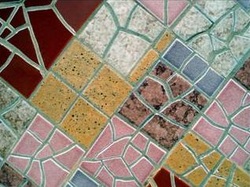
Ceramic Tiles
Ceramics are made from firing clay with minerals. The results can be earthenware, stoneware or porcelain. Each type has a different level of porousness so if you want to put a mosaic outside be sure to select a tile that is frost proof. For instance wall tiles are porous, which means they will absorb water and may crack if subjected to a frost.
For the best colours look for tiles specifically made for the mosaic market. Whilst these are slightly more expensive than the local hardware store variety, they have a richer colour choice. That said you can still use the hardware store variety but be sure they are suitable for the project you have in mind. Ceramic tiles are an easy and cheap tesserae to use to get started.
Ceramics are made from firing clay with minerals. The results can be earthenware, stoneware or porcelain. Each type has a different level of porousness so if you want to put a mosaic outside be sure to select a tile that is frost proof. For instance wall tiles are porous, which means they will absorb water and may crack if subjected to a frost.
For the best colours look for tiles specifically made for the mosaic market. Whilst these are slightly more expensive than the local hardware store variety, they have a richer colour choice. That said you can still use the hardware store variety but be sure they are suitable for the project you have in mind. Ceramic tiles are an easy and cheap tesserae to use to get started.
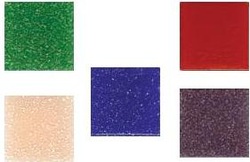
Vitreous Glass Tiles
These tiles come in an amazing array of colours and are impermeable making them an excellent choice of tesserae for outdoor projects as they won’t stain and are frost resistant.
I only use high quality vitreous tiles in my work because they are more reliable when cutting and less brittle. It can be very annoying when cutting vitreous tiles only to have them shatter – such a waste.
My advice is to buy the best quality you can afford. The highest quality will be from Italy. I only stock these tiles.
These tiles come in an amazing array of colours and are impermeable making them an excellent choice of tesserae for outdoor projects as they won’t stain and are frost resistant.
I only use high quality vitreous tiles in my work because they are more reliable when cutting and less brittle. It can be very annoying when cutting vitreous tiles only to have them shatter – such a waste.
My advice is to buy the best quality you can afford. The highest quality will be from Italy. I only stock these tiles.
Available in 10mm x 10mm, 20mm x 20mm and 25mm x 25mm.
These are a very versatile tile to use in all mosaic projects, they are easy to cut using wheeled glass cutters, and are relatively inexpensive.
The underside of a vitreous glass tile is grooved to help with adhesion. They are sold either singly or on mesh or brown paper sheets.
These are a very versatile tile to use in all mosaic projects, they are easy to cut using wheeled glass cutters, and are relatively inexpensive.
The underside of a vitreous glass tile is grooved to help with adhesion. They are sold either singly or on mesh or brown paper sheets.
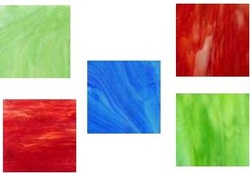
Stained Glass
I love stained glass – I’m like a kid in a lolly shop when going through my stained glass supplies. Although I have to say I do get excited by all my other goodies too – I just love the colours, shapes, textures and possibilities they present to me.
Stained glass is available in almost any colour and colour combination imaginable. You can buy hobby sheets (27cm x 13.5cm) that are easy to cut into shapes using a glass cutter and running pliers, or buy 20mm x 20mm tiles singly or on sheets.
To add pizzazz to any project the addition of stained glass is a must.
I love stained glass – I’m like a kid in a lolly shop when going through my stained glass supplies. Although I have to say I do get excited by all my other goodies too – I just love the colours, shapes, textures and possibilities they present to me.
Stained glass is available in almost any colour and colour combination imaginable. You can buy hobby sheets (27cm x 13.5cm) that are easy to cut into shapes using a glass cutter and running pliers, or buy 20mm x 20mm tiles singly or on sheets.
To add pizzazz to any project the addition of stained glass is a must.
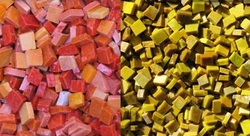
Smalti
Smalti is the queen of tesserae; the classic mosaic material first used hundreds of years ago.
It is handmade opaque glass made by firing molten glass with oxides. Smalti has an irregular and highly reflective surface that catches the light beautifully. Because of the uneven surface smalti mosaics are left ungrouted so that the pits and recesses do not become filled with grout.
Smalti was first made in Venice, Italy by Angelo Orsoni and quickly became the material of choice by master mosaicists throughout the world. Orsoni creates over 10,000 colours of Smalti – that is just more than I can imagine. It possesses a richness, a reflectivity, and a depth of colour that just cannot be matched.
Smalti is expensive due to the labour intensive manufacturing process but a few pieces can add a touch of luxury to any piece.
Smalti is the queen of tesserae; the classic mosaic material first used hundreds of years ago.
It is handmade opaque glass made by firing molten glass with oxides. Smalti has an irregular and highly reflective surface that catches the light beautifully. Because of the uneven surface smalti mosaics are left ungrouted so that the pits and recesses do not become filled with grout.
Smalti was first made in Venice, Italy by Angelo Orsoni and quickly became the material of choice by master mosaicists throughout the world. Orsoni creates over 10,000 colours of Smalti – that is just more than I can imagine. It possesses a richness, a reflectivity, and a depth of colour that just cannot be matched.
Smalti is expensive due to the labour intensive manufacturing process but a few pieces can add a touch of luxury to any piece.
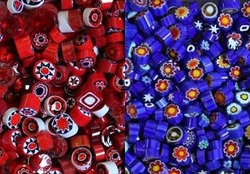
Millefiori “a thousand flowers”
Millefiori are thin rods of patterned glass that are cut into small discs and used in fusing and glass blowing. This material can be traced back to ancient Egypt although it is associated most commonly with Venetian glassmaking. The famous Murano Glass Factory on the island of Murano is well worth a visit if you are ever in Venice.
If using Millefiori be sure you have enough of the design you want to use because there is no regularity between batches so if re-ordering you can not be guaranteed of the same exact design.
Millefiori are thin rods of patterned glass that are cut into small discs and used in fusing and glass blowing. This material can be traced back to ancient Egypt although it is associated most commonly with Venetian glassmaking. The famous Murano Glass Factory on the island of Murano is well worth a visit if you are ever in Venice.
If using Millefiori be sure you have enough of the design you want to use because there is no regularity between batches so if re-ordering you can not be guaranteed of the same exact design.
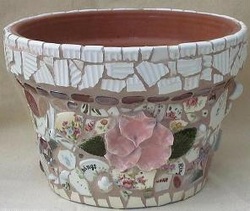
China and Tableware
Mosaics composed mainly of pieces of dishes are called “pique-assiette” a French term that means “one who eats from others plates”.
The term was originally applied to Raymond Isodore, a Frenchman who dug up shards of china around his home near Chatres. He completely covered the outside and inside of his house with these shards. Called “La Maison Picasiette” it has become a mosaic shrine and tourist attraction.
Using your own old and broken china as tesserae will create a unique and personal piece of art for your home or garden.
However, one word of warning – most china has a glazed surface which means it may not be suitable for long term outdoor use.
Mosaics composed mainly of pieces of dishes are called “pique-assiette” a French term that means “one who eats from others plates”.
The term was originally applied to Raymond Isodore, a Frenchman who dug up shards of china around his home near Chatres. He completely covered the outside and inside of his house with these shards. Called “La Maison Picasiette” it has become a mosaic shrine and tourist attraction.
Using your own old and broken china as tesserae will create a unique and personal piece of art for your home or garden.
However, one word of warning – most china has a glazed surface which means it may not be suitable for long term outdoor use.
Home
›
Getting Started
›
Tesserae

